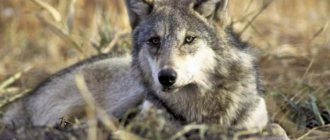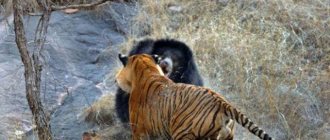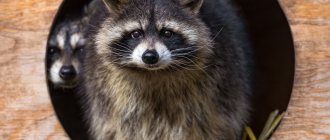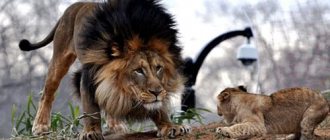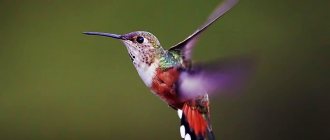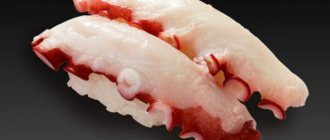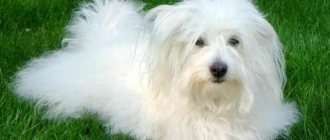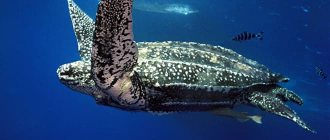In nature, everything is closely interconnected. Animals are connected to birds, plants, air, rivers and all living things around them. Moreover, they all exist in harmony with each other, living according to the unspoken law of hierarchy. This law is preserved due to the presence of a leader among animals, who is the lion. But why is the lion called the king among animals? Let's try to understand this issue with the help of this article.
Appearance
People have always endowed the lion with the best qualities. These are invincibility, nobility, loyalty and courage. However, it is known that the majestic cat in the animal world is not at all the most agile, fast and intelligent among other large predators.
So why are lions called the “king of beasts”?
This animal has always inspired fear. Many factors speak about his greatness. First of all, it is the appearance of a predator.
Among felines, he is the absolute record holder for shoulder height. The luxurious mane of males can reach 40 cm in length. It begins to grow in lion cubs at the age of six months, and over time it becomes more luxuriant and thicker.
In each individual it grows individually, depending on its subspecies, living conditions, in particular, temperature. However, the main factors in its development remain the level of the hormone testosterone.
The lion also has well-developed, powerful legs. During hunting, strong jaws play a huge role; often the length of the fangs reaches 8 cm. The color of the “king of beasts” varies from dark brown to yellowish. Usually the lower part of the body is lighter in color than the upper part, and the tip of the tail always has a black “tassel”.
It is worth noting that the female does not have a mane. This is due to the fact that she often participates in hunting, during which her luxurious hair can get in the way, complicating camouflage.
Lions could compete with tigers for the title of “king of beasts,” but they lose to the latter in the weight category. The weight of an adult male lion can reach 150-250 kg, while females are only 120-180 kg. The height at the shoulders is 123 and 107 cm, respectively.
Hybrid representatives
The king of the animal world was often crossed with other felines, resulting in various hybrids.
A liger was born from a tigress. This is the largest representative of cats. Its height can exceed 4 meters, and its weight can exceed 300 kg. The male liger looks like a huge lion with barely visible stripes. The females of this hybrid are capable of reproducing offspring.
Tigrolev, or tion (English tiger and lion), in turn, is born from a lioness and a tiger. Its dimensions are much more modest - it weighs about 150 kg. They may have characteristics of both animals - spots on the skin from the mother or dark stripes from the father. Unlike the liger, which is too heavy to hunt, the tion is able to survive in the wild.
Pride
Answering the question: “Why is the lion the king of beasts?”, it is necessary to pay attention to the organization of the family structure of the predator. The male is the real head of the family. Groups of animals (prides), as a rule, consist of 5-6 females, who are sisters, 1-2 males and growing offspring until they reach puberty.
Some lions lead a solitary lifestyle. These are mostly young individuals who left the pride in search of their own. Thus, lions do not inbreed.
The leader of the group, as a rule, spends most of his time defending the territory of his pride and protecting his family. The king of beasts is feared and respected. The strict hierarchy is well felt. He is always the first to start the meal. If one of the family members tries to disobey, then punishment takes place, including expulsion from the pride.
More often than not, the “reign” of a lion is short. On average it is 2-3 years. After which a stronger and younger male comes and “overthrows” the leader.
"Reign" of the lion
Like a real king, the lion does not retain his post for long, as he is overthrown by a younger and stronger male after 2-3 years of reign. This successor is a stranger, that is, he is not a blood relative to the females of the pride. After ascending to the throne, the male kills the cubs of the previous male, protecting himself from attack by future rivals and thereby stimulating the reproductive instinct in females. However, over time, any male ages and loses his power, then young lions come to replace him again.
Probably, it is these complex relationships between members of the pride, the struggle of males for power and the recognition of the strongest of them as the leader of the pack that gives the right to call the lion the king of beasts.
Territory
Like the ruler of any state, the lion, the king of beasts, carefully monitors the borders of his domain. He constantly walks around the territory and marks it. And with its famous loud roar, which can be heard for several kilometers, it also reminds of its presence. He is ready to fight to the death for the territory where his pride lives.
The basis for this behavior is the need to protect females from other males. The area of property largely depends on the number of animals that become prey for lions. If there are not enough of them, the boundaries can extend up to 30 km in diameter.
There are also lions that constantly follow migrating herds of animals.
The conquest of territory and pride from predators occurs by force. Fights for dominance between males are usually very bloody. Often both opponents die in the end. Lionesses constantly drive away alien females who try to join the pride.
Young males often wander around the borders of the territory. These are new contenders for pride leaders. If one of them achieves success, they will already say about him: “The lion is the king of beasts.” But they still lack the courage and strength to challenge the owner of the territory. However, with their presence they remind that his “reign” will not last forever.
White lions
These are not hybrids, but animals with reduced melanin production. The cause of this very rare phenomenon is a recessive gene. As a result of its exposure, a very light color appears, which can vary from creamy beige to white. Some white lions have some parts of their bodies painted this color, and others creamy; there are individuals with an even white-cream color.
Often white lions, descriptions of which are often found in specialized literature, have blue eyes (which is also explained by low levels of melanin). Today, the planet is inhabited by only about three hundred white individuals. Special programs have been developed to preserve these animals. Living in the wild, lions with this color have a difficult life: this color unmasks them, making hunting difficult.
Hunting
The definition of “the lion is the king of beasts” is also confirmed by the methods of obtaining food. The fact is that the leader of the pride does not participate in the hunt. Lioness go in search of prey.
Females are more dexterous and mobile. It's easier for them to catch the victim. They hunt in groups. Having chosen potential prey, they pursue it in a group.
However, they cannot run fast for long, only for short distances, so they mostly go out at night to search for prey.
The victims are large mammals: zebras, wildebeest, wild boars, gazelles, deer. During the hunt for a buffalo or giraffe, the “king of beasts” himself may join the females. At the same time, predators quietly creep up on the herd from all sides at once. As soon as the distance becomes less than 30 meters, the lions pounce on the nearest animal.
After this, a powerful attack begins. With a quick jump they catch the victim and begin to strangle him. Smaller animals die even from a blow from a paw.
The lion is always the first to start the meal; only when he is full do the females and their offspring approach the prey.
Population protection
The lion is listed in the International Red Book as a vulnerable species. The king of animals has no natural enemies, but he is threatened by the destruction of his natural habitat and poaching. Leopards, hyenas and other predators also pose a threat to small lion cubs. A danger to genetic diversity and population health is the isolation of different parts of the range from each other, leading to inbreeding.
Poachers are the main and most serious problem of the population. Unfortunately, animals cannot feel calm even in nature reserves, and the reason for this is illegal hunting. In addition, in 6 African states, trophy hunting of these rare mammals is not prohibited.
The number of the Asian subspecies has been significantly increased in recent years, while its African counterpart is already considered endangered, and its population, despite all the efforts of ecologists and zoologists, continues to fall. The only way to maintain the population at the moment is breeding in nature reserves, as well as maintaining the number of herbivores that form the basis of Panthera Leo’s food supply.
Why is the lion the king of beasts? Reproduction
When the female reaches the age of four, she reaches puberty. Now she is ready to breed.
During ovulation, a lioness can mate with several males at once up to 20-40 times a day.
Offspring can appear at any time of the year. However, females in a pride usually have cubs all at the same time. This makes it easier to protect and feed the offspring.
Pregnancy lasts on average 110 days. Before giving birth, the predator leaves her pack, finds a secluded place, and there gives birth to up to 3-4 kittens.
Lion cubs are born blind and helpless, weighing up to 2 kg. After a week, their eyes open, and they begin to walk only after a month.
Several times during the month the female changes her place of residence. This is how she protects her children from other predators.
Two months later she returns to her pride with the cubs. For 6-8 weeks they eat only mother's milk, after which they begin to try meat. At 6-7 months, lactation stops.
The male treats his offspring according to his mood. He can either play with them or drive them away.
The female is in charge of educating the younger generation. Almost all skills used during hunting are learned rather than innate instincts.
When the leader of the pack changes, the offspring may be in danger. A young lion is capable of killing growing kittens so that the female is again ready for mating.
Life cycle
The fact that the lion is the king of beasts also confirms his difficult path to “power”.
Only 20% of all offspring survive to two years; most often they become victims of predators.
In natural conditions, lions live up to 14 years, in captivity - up to 20. Many individuals die during fights for territory and primacy in the pride. The “king of beasts” reaches sexual maturity by the age of 3. By the age of 4-5 they can claim the role of leader in the group.
If the number of a pride becomes large, then not only males, but also females can be expelled from it. Also, when the new leader seizes the championship, the same fate awaits all immature lionesses.
If they are unable to join another group, then a very harsh life awaits them, since raising offspring alone is almost impossible.
Other predators and the “king of beasts”
Lions tend to dominate other, smaller felines. Cheetahs and leopards try to avoid larger predators and carefully hide their offspring from them. Most of the cubs die precisely because of lion attacks.
Even the fact that smaller predators try not to compete during food production does not always save.
Hyenas are always close to lions, but try to keep their distance. In the absence of aggression from scavengers, the graceful cat does not pay attention to them. However, attacks on hyenas are not uncommon.
The real danger to the lion is the Nile crocodiles. While attacking each other, both sides suffer serious injuries.
Biological significance
The animals described are a link at the top of the food chain in their territory. They ensure natural selection in herds of large ungulates, eating the weakest and sickest. The remains of their prey serve as food for scavengers: hyenas and vultures.
The greatest of felines has a very important influence on the entire ecosystem in which it lives: the remains of its prey fertilize the soil, it carries seeds of various plants on its skin, and parasitic insects feed on its blood.
Extinction of a species
Nowadays, you can mainly see a lion only in the zoo. However, even in the Middle Ages, graceful predators, in addition to Africa, lived in Iran, Europe and the Middle East. They could also be found in some regions of Russia.
Nowadays, many extinct subspecies of these representatives of the cat family are known, and some of them disappeared due to human fault even less than 100 years ago.
Lion populations are decreasing every year; in the last two decades alone, these predators have decreased by 40%.
The main reasons for the decline in numbers are climate change, which leads to loss of key habitats, disease, and human intervention.
The large graceful predator began to be kept in zoos since the 18th century. The main goal is to preserve lions as a species, as well as to show exotic animals to people.
Here they carefully monitor the reproduction of the predator. At the same time, they try to maintain the purity of the subspecies. Animals here live longer and reach larger sizes and weights.
Security status
The Barbary lion (Panthera leo leo) and the Cape lion (Panthera leo melanochaita) are two extinct subspecies of the African lion. The African lion population has declined significantly in numbers in West Africa and other African countries. If there are no corridors between reserves, genetic diversity will likely become an issue.
Asiatic lions (Panthera leo persica) are limited to one population and are found in the Gir Forest Reserve of India. The population size is about 200 mature individuals. This subspecies is listed as endangered. The Asiatic lion population is in dire need of recovery. Threats to the inhabitants of the Gir Forest come from humans and livestock in the immediate vicinity, as well as from habitat degradation.
Some small populations of lions require genetic control for continued survival and conservation of the species. For example, in Hluhluwe-Umfolozi Park in Natal, there are 120 individuals that have been bred from just three lions since 1960. In 2001, scientists used artificial insemination techniques to rejuvenate the gene pool of these South African lions. This process is quite complex and energy-intensive. Inbred populations could also be introduced into entire prides within a given area (thus minimizing conflict between existing and introduced lions).

